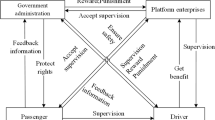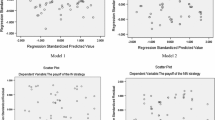Abstract
With the popularity of the sharing economy, ride-hailing services have greatly affected people’s travel and become a new travel mode for urban residents. However, the lack of effective industry regulation has resulted in serious operational problems and growing difficulties in the furthering development of ride-hailing services in China. Therefore, it is necessary to study the regulation strategies of multiple subjects involved in ride-hailing industry. Based on evolutionary game theory, the paper establishes the tripartite evolution game model about regulation strategies of ride-hailing industry. The theoretical research and simulation results show that the evolutionarily stable strategy of a single subject (Transportation Network Company, driver or passenger) is affected by the strategies of other two subjects together. Moreover, when making the decision, the Transportation Network Companies (TNCs) need to consider the difference between benefits and costs, user scale, incentives and penalties from the government. Drivers need to consider their benefits and costs, travel user scale and penalties from the government and the TNCs. Besides, the benefits and costs, and the harmony of ride-hailing industry need to be considered for passengers. Potential policy implications are proposed.





Similar content being viewed by others
Notes
China, The Credit Assessment Method of Taxi Service Quality, §6(31,32) (2018).
China, Interim Measures for the Administration of Online Taxi Booking Business Operations and Services, §6(34, 35, 37) (2016). China, The Credit Assessment Method of Taxi Service Quality, §6(33) (2018).
China, The Credit Assessment Method of Taxi Service Quality, §6(34) (2018).
China, The Credit Assessment Method of Taxi Service Quality, §6(35,36) (2018).
China, Interim Measures for the Administration of Online Taxi Booking Business Operations and Services, §6(36, 37) (2016).
References
Ganapati, S., & Reddick, C. G. (2018). Prospects and challenges of sharing economy for the public sector. Government Information Quarterly,35(1), 77–87.
Zuo, W., Zhu, W., Chen, S., & He, X. (2019). Service quality management of online car-hailing based on PCN in the sharing economy. Electronic Commerce Research and Applications,34, 100827.
Nguyen-Phuoc, D. Q., Su, D. N., Tran, P. T. K., Le, D.-T. T., & Johnson, L. W. (2020). Factors influencing customer’s loyalty towards ride-hailing taxi services—A case study of Vietnam. Transportation Research Part A: Policy and Practice,134, 96–112.
Rayle, L., Dai, D., Chan, N., Cervero, R., & Shaheen, S. (2016). Just a better taxi? A survey-based comparison of taxis, transit, and ridesourcing services in San Francisco. Transport Policy,45, 168–178.
The Chinese Ministry of Transport. (2016). Interim measures for the administration of online taxi booking business operations and services. Retrieved July 28, 2016, from http://zizhan.mot.gov.cn/zfxxgk/bnssj/zcfgs/201607/t20160728_2068633.html.
Jin, S. T., Kong, H., Wu, R., & Sui, D. Z. (2018). Ridesourcing, the sharing economy, and the future of cities. Cities,76, 96–104.
The Chinese Ministry of Transport. (2018). The credit assessment method of taxi service quality. Retrieved May 24, 2018, from http://www.crta.org.cn/article-3447.html.
Yu, J. J., Tang, C. S., Shen, Z. J. M., & Chen, X. (2019). A balancing act of regulating on-demand ride services. Management Science. https://ssrn.com/abstract=2990209.
Zhang, G., Ma, L., Zhang, X., Ding, X. Y., & Yang, Y. P. (2019). Risk perception and intention to discontinue use of ride-hailing services in China: Taking the example of DiDi Chuxing. Transportation Research Part F: Traffic Psychology and Behavior,66, 459–470.
Guo, Y., Xin, F., & Li, X. (2019). The market impacts of sharing economy entrants: Evidence from USA and China. Electronic Commerce Research. https://doi.org/10.1007/s10660-018-09328-1.
Wadud, Z. (2020). An examination of the effects of ride-hailing services on airport parking demand. Journal of Air Transport Management,84, 101783.
David, E., & Jon, K. (2013). Networks, crowds, and markets: Reasoning about a highly connected world. Cambridge: Cambridge University Press.
Weibull, J. W. (1998). Evolution, rationality and equilibrium in games. European Economic Review,42(3), 641–649.
Watanabe, C., Naveed, K., & Neittaanmäki, P. (2016). Co-evolution of three mega-trends nurtures un-captured GDP—Uber’s ride-sharing revolution. Technology in Society,46, 164–185.
Wang, Y., Wang, S., Wang, J., Wei, J. C., & Wang, C. L. (2018). An empirical study of consumers’ intention to use ride-sharing services: Using an extended technology acceptance model. Transportation. https://doi.org/10.1007/s11116-018-9893-4.
Amirkiaee, S. Y., & Evangelopoulos, N. (2018). Why do people rideshare? An experimental study. Transportation Research Part F: Traffic Psychology & Behaviour,55, 9–24.
Lavieri, P. S., & Bhat, C. R. (2019). Investigating objective and subjective factors influencing the adoption, frequency, and characteristics of ride-hailing trips. Transportation Research Part C: Emerging Technologies,105, 100–125.
Tirachini, A., & Gomez-Lobo, A. (2019). Ride-hailing in Santiago de Chile: Users’ characterization and effects on travel behavior. Transport Policy,82, 46–57.
Sui, Y., Zhang, H., Song, X., Shao, F., Yu, X., et al. (2019). GPS data in urban online ride-hailing: A comparative analysis on fuel consumption and emissions. Journal of Cleaner Production,227, 495–505.
Cetin, T., & Deakin, E. (2019). Regulation of taxis and the rise of ridesharing. Transport Policy,76, 149–158.
Nie, Y. (2017). How can the taxi industry survive the tide of ridesourcing? Evidence from Shenzhen, China. Transportation Research Part C: Emerging Technologies,79, 242–256.
Sun, L., Teunter, R. H., Babai, M. Z., & Hua, G. (2019). Optimal pricing for ride-sourcing platforms. European Journal of Operational Research,278(3), 783–795.
Contreras, S. D., & Paz, A. (2018). The effects of ride-hailing companies on the taxicab industry in Las Vegas, Nevada. Transportation Research Part A: Policy and Practice,115, 63–70.
Botsman, R., & Rogers, R. (2011). What’s mine is yours: The rise of collaborative consumption. New York: Harper Business.
Wirtz, J., & Tang, C. S. (2016). Uber—Competing as market leader in the U.S. versus being a distant second in China. In J. Wirtz & C. Lovelock (Eds.), Services marketing: People, technology, strategy. Singapore: World Scientific. https://doi.org/10.1142/9781944659028_0019.
Beer, R., Brakewood, C., Rahman, S., & Viscardi, J. (2017). Qualitative analysis of ride-hailing regulations in major American cities. Transportation Research Record: Journal of the Transportation Research Board,2650, 84–91.
Lagadic, M., Verloes, A., & Louvet, N. (2019). Can carsharing services be profitable? A critical review of established and developing business models. Transport Policy,77, 68–78.
Barann, B., Beverungen, D., & Müller, O. (2017). An open-data approach for quantifying the potential of taxi ridesharing. Decision Support Systems,99, 86–95.
Shou, Z., Di, X., Ye, J., Zhu, H., Zhang, H., & Hampshire, R. (2020). Optimal passenger-seeking policies on E-hailing platforms using Markov decision process and imitation learning. Transportation Research Part C: Emerging Technologies,111, 91–113.
Zeto, W. Y. S., Wong, R. C. P., & Yang, W. H. (2019). A sequential binary logistic regression model is proposed for the dynamic decision-making process of vacant taxi drivers. Transport Policy,76, 100–110.
Xu, Z., Yin, Y., & Ye, J. (2020). On the supply curve of ride-hailing systems. Transportation Research Part B: Methodological,132, 29–43.
Yang, H., Shao, C., Wang, H., & Ye, J. (2020). Optimizing matching time interval and matching radius in on-demand ride-sourcing markets. Transportation Research Part B: Methodological,131, 84–105.
Wang, S., & Smart, M. (2020). The disruptive effect of ridesourcing services on for-hire vehicle drivers’ income and employment. Transport Policy,89, 13–23.
Rogers, B. (2015). The social costs of Uber. SSRN Electronic Journal. https://doi.org/10.2139/ssrn.2608017.
Herbert, A. (2016). Portlandia, ridesharing, and sex discrimination. Michigan Law Review,115(18), 18–25.
Hou, D. H. (2015). Legitimacy and supervision system of internet private hire vehicles. Journal of University of Science & Technology Beijing,31(6), 96–103.
Flores, O., & Rayle, L. (2017). How cities use regulation for innovation: The case of Uber, Lyft and sidecar in San Francisco. Transportation Research Procedia,25, 3760–3772.
Bengtsson, N. (2015). Efficient informal trade: Theory and experimental evidence from the Cape Town taxi market. Journal of Development Economics,115, 85–98.
Li, S., Tavafoghi, H., Poolla, K., & Varaiya, P. (2019). Regulating TNCs: Should Uber and Lyft set their own rules? Transportation Research Part B: Methodological,129, 193–225.
Fisher, R. A. (1930). The genetical theory of natural selection: A complete variorum edition. Oxford: Oxford University Press.
Lewontin, R. C. (1976). Evolution and the theory of games. Journal of Theoretical Biology,1(3), 382–403.
Smith, J. M., & Price, G. R. (1973). The logic of animal conflict. Nature,246, 15–18.
Taylor, P. D., & Jonker, L. B. (1978). Evolutionarily stable strategies and game dynamics. Mathematical Biosciences,40(1), 145–156.
Smith, J. M. (1982). Evolution and the theory of games. Cambridge: Cambridge University Press.
Nash, J. F. (1950). Equilibrium points in n-person games. Proceedings of the National Academy of Sciences of the United States of America,36(1), 48–49.
Roca, C. P., Cuesta, J. A., & Sánchez, A. (2009). Evolutionary game theory: Temporal and spatial effects beyond replicator dynamics. Physics of Life Reviews,6(4), 208–249.
Johari, M., Hosseini-Motlagh, S.-M., & Rasti-Barzoki, M. (2019). An evolutionary game theoretic model for analyzing pricing strategy and socially concerned behavior of manufacturers. Transportation Research Part E: Logistics and Transportation Review,128, 506–525.
Damme, E. V. (1987). Evolutionary game theory. Stability and perfection of Nash equilibrium. Berlin: Springer.
Coninx, K., Deconinck, G., & Holvoet, T. (2018). Who gets my flex? An evolutionary game theory analysis of flexibility market dynamics. Applied Energy,218, 104–113.
Chen, S., He, Q., & Xiao, H. (2020). A study on cross-border e-commerce partner selection in B2B mode. Electronic Commerce Research. https://doi.org/10.1007/s10660-020-09403-6100827.
Zhao, T., & Liu, Z. (2019). A novel analysis of carbon capture and storage (CCS) technology adoption: An evolutionary game model between stakeholders. Energy,189, 116352.
Zuo, Y., Zhao, X. G., Zhang, Y. Z., & Zhou, Y. (2019). From feed-in tariff to renewable portfolio standards: An evolutionary game theory perspective. Journal of Cleaner Production,213, 1274–1289.
Liu, Q., Dou, F., & Meng, X. (2019). Effectiveness research on the multi-player evolutionary game of coal-mine safety regulation in China based on system dynamics. Safety Science,111, 224–233.
Mahmoudi, R., & Rasti-Barzoki, M. (2018). Sustainable supply chains under government intervention with a real-world case study: An evolutionary game theoretic approach. Computers & Industrial Engineering,116, 130–143.
Encarnação, S., Santos, F. P., Santos, F. C., Blass, V., Pacheco, J. M., et al. (2018). Paths to the adoption of electric vehicles: An evolutionary game theoretical approach. Transportation Research Part B Methodological,113, 24–33.
Li, J., Jiao, J., & Tang, Y. (2019). An evolutionary analysis on the effect of government policies on electric vehicle diffusion in complex network. Energy Policy,129, 1–12.
Iwamura, Y., & Tanimoto, J. (2018). Complex traffic flow that allows lane-changing and hampering intrinsically contains social-dilemma structures. Journal of Statistical Mechanics: Theory and Experiment. https://doi.org/10.1088/1742-5468/aaa8ff.
Lei, L. C., & Gao, S. (2019). Transportation network companies and drivers dilemma in China: An evolutionary game theoretic perspective. Transport,34(05), 579–590.
Sun, Q. P., He, Y. Q., Wang, Y. J., & Ma, F. (2019). Evolutionary game between government and ride-hailing platform: Evidence from China. Discrete Dynamics in Nature and Society. https://doi.org/10.1155/2019/9545102.
Nisan, N., Roughgarden, T., Tardos, E., & Vazirani, V. V. (2007). Algorithmic game theory. Cambridge: Cambridge University Press.
Selten, R. (1980). A note on evolutionarily stable strategies in asymmetric animal conflicts. Journal of Theoretical Biology,84(1), 93–101.
Ritzberger, K., & Weibull, W. (1996). Evolutionary selection in normal form games. Econometrica,63(6), 71–99.
Friedman, A. (1991). A simple testable model of double auction markets. Journal of Economic Behavior & Organization,15(1), 47–70.
Lyapunov, A. M. (1994). The general problem of the stability of motion. International Journal of Control,31(3), 353–354.
Xiong, Huiyuan, Zhu, Xionglai, & Zhang, Ronghui. (2018). Energy recovery strategy numerical simulation for dual axle drive pure electric vehicle based on motor loss model and big data calculation. Complexity,2018, 1–14.
Acknowledgements
The authors are very grateful to the anonymous referees for their insightful, constructive, and valuable comments and suggestions. The research was partially supported by the Ministry of Education Layout Foundation of Humanities and Social Sciences under Grant number 19YJA630030, the Social Science Foundation of Hunan Province under Grant Number 17YBA369, and the National Natural Science Foundation of China under Grant Number 71801185.
Author information
Authors and Affiliations
Corresponding author
Ethics declarations
Conflict of interest
The authors declare that there is no conflict of interest.
Additional information
Publisher's Note
Springer Nature remains neutral with regard to jurisdictional claims in published maps and institutional affiliations.
Rights and permissions
About this article
Cite this article
Lei, Lc., Gao, S. & Zeng, Ey. Regulation strategies of ride-hailing market in China: an evolutionary game theoretic perspective. Electron Commer Res 20, 535–563 (2020). https://doi.org/10.1007/s10660-020-09412-5
Published:
Issue Date:
DOI: https://doi.org/10.1007/s10660-020-09412-5




